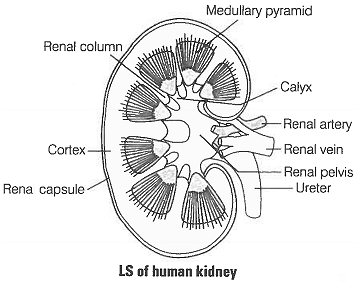Human kidney are reddish-brown, bean-shaped structures situated between the last thoracic and third lumbar vertebra close to the dorsal inner wall of the abdominal cavity. Each kidney of an adult human measures 10-12 cm in length, 5-7 cm in width, 2-3 cm in thickness with an average weight of 120-170 gm.
The kidney is covered by fibrous connective tissue, the renal capsula, which protect the kidney.Internally, it consists of outer dark cortex and an inner light medulla, both containing nephron (structural and functional units of kidney.)
The median conconcave border of a kidney contains a notch called hilum. Through which ureter blood vessels and urinitus.
The renal cortex is granular in apperance and contains convoluted tubules and Malpighian corpuscles. The renal medulla contains loop of Henle, collecting ducts and tubules and ducts of Bellini.
Medulla is divided into conical masses, the medullary pyramids which further form papillae.The papillae form calyces, which join to renal pelvis leading to ureter. Between the medullary pyramids, cortex extends into medulla and forms renal columns which are called as column of Bertini.

